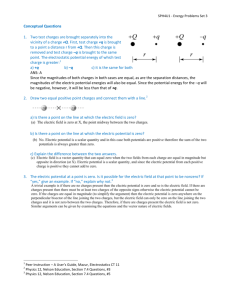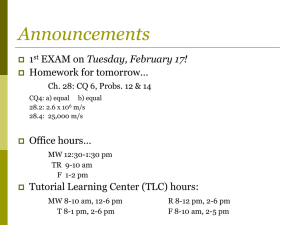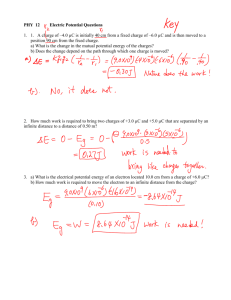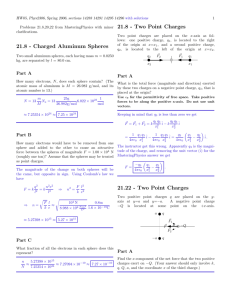Electric Force Solutions
advertisement
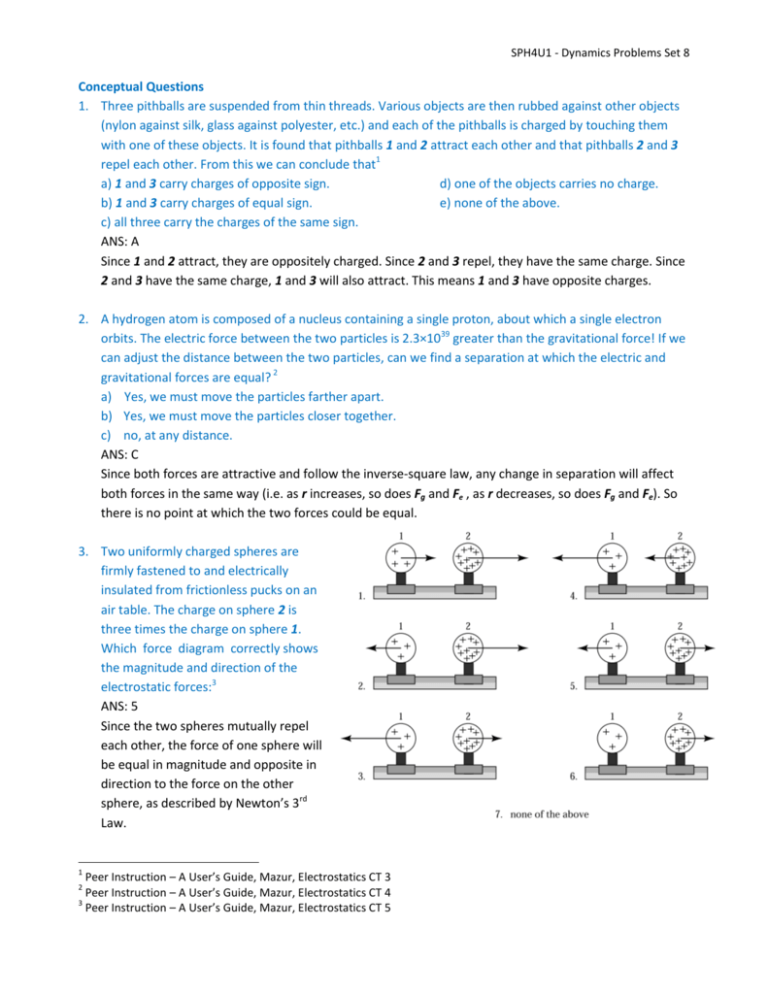
SPH4U1 - Dynamics Problems Set 8 Conceptual Questions 1. Three pithballs are suspended from thin threads. Various objects are then rubbed against other objects (nylon against silk, glass against polyester, etc.) and each of the pithballs is charged by touching them with one of these objects. It is found that pithballs 1 and 2 attract each other and that pithballs 2 and 3 repel each other. From this we can conclude that1 a) 1 and 3 carry charges of opposite sign. d) one of the objects carries no charge. b) 1 and 3 carry charges of equal sign. e) none of the above. c) all three carry the charges of the same sign. ANS: A Since 1 and 2 attract, they are oppositely charged. Since 2 and 3 repel, they have the same charge. Since 2 and 3 have the same charge, 1 and 3 will also attract. This means 1 and 3 have opposite charges. 2. A hydrogen atom is composed of a nucleus containing a single proton, about which a single electron orbits. The electric force between the two particles is 2.3×1039 greater than the gravitational force! If we can adjust the distance between the two particles, can we find a separation at which the electric and gravitational forces are equal? 2 a) Yes, we must move the particles farther apart. b) Yes, we must move the particles closer together. c) no, at any distance. ANS: C Since both forces are attractive and follow the inverse-square law, any change in separation will affect both forces in the same way (i.e. as r increases, so does Fg and Fe , as r decreases, so does Fg and Fe). So there is no point at which the two forces could be equal. 3. Two uniformly charged spheres are firmly fastened to and electrically insulated from frictionless pucks on an air table. The charge on sphere 2 is three times the charge on sphere 1. Which force diagram correctly shows the magnitude and direction of the electrostatic forces:3 ANS: 5 Since the two spheres mutually repel each other, the force of one sphere will be equal in magnitude and opposite in direction to the force on the other sphere, as described by Newton’s 3rd Law. 1 Peer Instruction – A User’s Guide, Mazur, Electrostatics CT 3 Peer Instruction – A User’s Guide, Mazur, Electrostatics CT 4 3 Peer Instruction – A User’s Guide, Mazur, Electrostatics CT 5 2 SPH4U1 - Dynamics Problems Set 4. We are not normally aware of the gravitational or electric force between two ordinary objects. What is the reason in each case? Give an example where we are aware of each one and why.4 5. Drawings I and II show two examples of electric field lines. Decide which of the following statements are true and which are false, defending your choice in each case. (a) In both I and II the electric field is the same everywhere. (b) As you move from left to right in each case, the electric field becomes stronger. (c) The electric field in I is the same everywhere but becomes stronger in II as you move from left to right. (d) The electric fields in both I and II could be created by negative charges located somewhere on the left and positive charges somewhere on the right. (e) Both I and II arise from a single positive point charge located somewhere on the left.5 4 5 th Physics 6 Edition, Giancoli, Chapter 16 Questions, #10 th Physics, 7 Edition, Cutnell & Johnson, Chapter 5 Problems, #27 SPH4U1 - Dynamics Problems Set 6. Three small, negatively charged spheres are located at the vertices of an equilateral triangle. The magnitudes of the charges are equal. Sketch the electric field in the region around this charge distribution, including the space inside the triangle.6 7. 8. 6 Problems Two small, oppositely charged conducting spheres experience a mutual electric force of attraction of magnitude 1.6 x 10 -2 N. What does this magnitude become if each sphere is touched with its identical, neutral mate, the initially neutral spheres are taken far away, and the separation of the two initially charged spheres is doubled?7 What are the magnitude and direction of the electric field strength at point Z in the diagram on the right? ?8 Physics 12, Nelson Education, Chapter 7 Review, #11 Physics 12, Nelson Education, Chapter 7 Review, #4 8 Physics 12, Nelson Education, Chapter 7 Review, #14 7 SPH4U1 - Dynamics Problems Set 9. Two point charges, +4.0 x 10 -5 C and –1.8 x 10 -5 C, are placed 24 cm apart. What is the force on a third small charge, of magnitude –2.5 x 10 -6 C, if it is placed on the line joining the other two,9 a) 12 cm outside the originally given pair of charges, on the side of the negative charge? 9 Physics 12, Nelson Education, Chapter 7 Review, #7 SPH4U1 - Dynamics Problems Set b) 12 cm outside the originally given pair of charges, on the side of the positive charge? c) midway between the originally given pair of charges? SPH4U1 - Dynamics Problems Set 10. One model of the structure of the hydrogen atom consists of a stationary proton with an electron moving in a circular path around it. The orbital path has a radius of 5.3x10-11 m. The masses of a proton and an electron are 1.67x10-27 kg and 9.1x10-31 kg, respectively.10 a) Calculate the electrostatic force between the electron and the proton. b) Calculate the gravitational force between them. c) Which force is mainly responsible for the electron’s circular motion? d) Calculate the speed and period of the electron in its orbit around the proton. 10 Physics 12, Nelson Education, Chapter 7 Review, #6 SPH4U1 - Dynamics Problems Set 11. Three positive particles of equal charge +11.0 μC are located at the corners of an equilateral triangle of side 15.0 cm. Calculate the magnitude and direction of the net force on each particle. 11 11 th Physics 6 Edition, Giancoli, Chapter 16 Problems, #13 SPH4U1 - Dynamics Problems Set 12. At each corner of a square of side l there are point charges of magnitude Q, 2Q, 3Q and 4Q. Determine the force due to the other three charges on 12 a) the charge 2Q b) the charge 3Q 13. Determine the direction and magnitude of the electric field at the point P shown in the diagram. The two charges are separated by a distance of 2a. Point P is on the perpendicular bisector of the line joining the charges, a distance x from the midpoint between them. Express your answers in terms of Q, x, a, and k. 13 12 13 th Physics 6 Edition, Giancoli, Chapter 16 Problems, #16 th Physics 6 Edition, Giancoli, Chapter 16 Problems, #40 SPH4U1 - Dynamics Problems Set 14. A metallic table tennis ball of mass 0.10 g has a charge of 5.0 x 10-6 C. What potential difference, across a large parallel plate apparatus of separation 25 cm, would be required to keep the ball stationary?14 15. An oil droplet of mass 2.6 x 10-15 kg, suspended between two parallel plates 0.50 cm apart, remains stationary when the potential difference between the plates is 270 V. What is the charge on the oil droplet? How many excess or deficit electrons does it have?15 14 15 Physics 12, Nelson Education, Chapter 7 Review, #28 Physics 12, Nelson Education, Chapter 7 Review, #27 SPH4U1 - Dynamics Problems Set 16. A ping-pong ball of mass 3.0 x10-4 kg hangs from a light thread 1.0 m long, between two vertical parallel plates 10.0 cm apart. When the potential difference across the plates is 420 V, the ball comes to equilibrium 1.0 cm to one side of its original position.16 a) Calculate the electric field strength between the plates. b) Calculate the tension in the thread. c) Calculate the magnitude of the electric force deflecting the ball. 16 Physics 12, Nelson Education, Chapter 7 Review, #15 SPH4U1 - Dynamics Problems Set d) Calculate the charge on the ball. 17. An electron moving to the right at 1.0 % the speed of light enters a uniform electric field parallel to its direction of motion. If the electron is to be brought to rest in the space of 4.0 cm, what direction is required for the electric field and what is the strength of the field?17 18. An electron enters a parallel plate apparatus 10.0 cm long and 2.0 cm wide, moving horizontally at 8.0 x 107 m/s. The potential difference between the plates is 6.0 x 102 V. Calculate18 a) the vertical deflection of the electron from its original path 17 18 th Physics 6 Edition, Giancoli, Chapter 16 Problems, #42 Physics 12, Nelson Education, Chapter 7 Review, #35 SPH4U1 - Dynamics Problems Set b) the velocity with which the electron leaves the parallel plate apparatus
